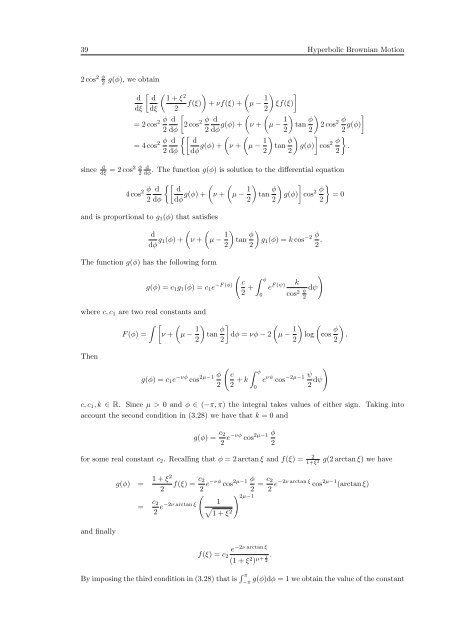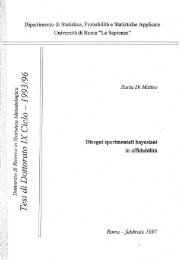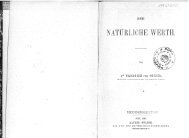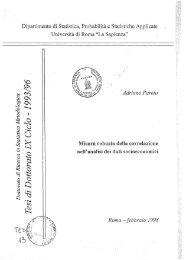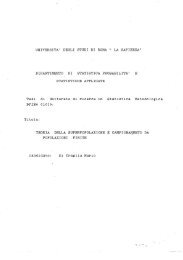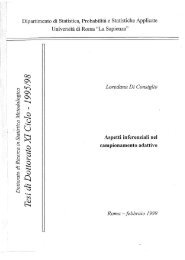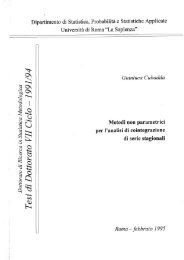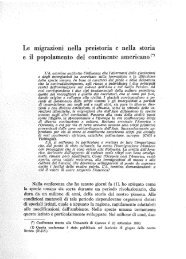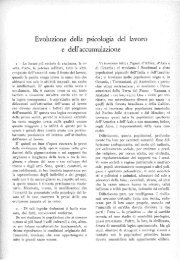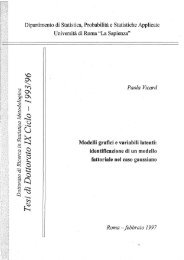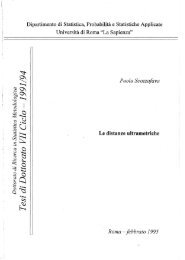Random Processes in Hyperbolic Spaces Hyperbolic Brownian ...
Random Processes in Hyperbolic Spaces Hyperbolic Brownian ...
Random Processes in Hyperbolic Spaces Hyperbolic Brownian ...
You also want an ePaper? Increase the reach of your titles
YUMPU automatically turns print PDFs into web optimized ePapers that Google loves.
39 <strong>Hyperbolic</strong> <strong>Brownian</strong> Motion<br />
2 φ<br />
2 cos 2 g(φ), we obta<strong>in</strong><br />
<br />
2<br />
d d 1 + ξ<br />
f(ξ) + νf(ξ) + µ −<br />
dξ dξ 2<br />
1<br />
<br />
ξf(ξ)<br />
2<br />
<br />
<br />
2 φ d 2 φ d<br />
= 2 cos 2 cos g(φ) + ν + µ −<br />
2 dφ 2 dφ 1<br />
<br />
tan<br />
2<br />
φ<br />
<br />
2 φ<br />
2 cos<br />
2 2 g(φ)<br />
<br />
<br />
2 φ d d<br />
= 4 cos g(φ) + ν + µ −<br />
2 dφ dφ 1<br />
<br />
tan<br />
2<br />
φ<br />
<br />
2 φ<br />
g(φ) cos .<br />
2<br />
2<br />
s<strong>in</strong>ce d<br />
dξ<br />
= 2 cos2 φ<br />
2<br />
d<br />
dφ<br />
2 φ d<br />
4 cos<br />
2 dφ<br />
and is proportional to g1(φ) that satisfies<br />
. The function g(φ) is solution to the differential equation<br />
<br />
d<br />
g(φ) + ν + µ −<br />
dφ 1<br />
<br />
tan<br />
2<br />
φ<br />
<br />
g(φ) cos<br />
2<br />
<br />
= 0<br />
2<br />
2 φ<br />
d<br />
dφ g1(φ)<br />
<br />
+ ν + µ − 1<br />
<br />
tan<br />
2<br />
φ<br />
<br />
−2 φ<br />
g1(φ) = k cos<br />
2<br />
2 .<br />
The function g(φ) has the follow<strong>in</strong>g form<br />
−F (φ)<br />
g(φ) = c1g1(φ) = c1e<br />
where c, c1 are two real constants and<br />
Then<br />
F (φ) =<br />
<br />
c<br />
2 +<br />
φ<br />
0<br />
F (ψ) k<br />
e<br />
cos2 ψ<br />
2<br />
<br />
ν + µ − 1<br />
<br />
tan<br />
2<br />
φ<br />
<br />
<br />
dφ = νφ − 2 µ −<br />
2<br />
1<br />
<br />
log cos<br />
2<br />
φ<br />
<br />
.<br />
2<br />
g(φ) = c1e −νφ <br />
2µ−1 φ c<br />
cos + k<br />
2 2<br />
φ<br />
0<br />
dψ<br />
<br />
e νψ −2µ−1 ψ<br />
cos<br />
2 dψ<br />
<br />
c, c1, k ∈ R. S<strong>in</strong>ce µ > 0 and φ ∈ (−π, π) the <strong>in</strong>tegral takes values of either sign. Tak<strong>in</strong>g <strong>in</strong>to<br />
account the second condition <strong>in</strong> (3.28) we have that k = 0 and<br />
g(φ) = c2<br />
2 e−νφ 2µ−1 φ<br />
cos<br />
2<br />
for some real constant c2. Recall<strong>in</strong>g that φ = 2 arctan ξ and f(ξ) = 2<br />
1+ξ 2 g(2 arctan ξ) we have<br />
and f<strong>in</strong>ally<br />
g(φ) =<br />
1 + ξ2<br />
2<br />
= c2 arctan ξ<br />
e−2ν<br />
2<br />
f(ξ) = c2<br />
2 e−νφ cos<br />
<br />
1<br />
<br />
1 + ξ2 f(ξ) = c2<br />
2µ−1 φ<br />
2<br />
2µ−1<br />
−2ν arctan ξ e<br />
(1 + ξ2 1<br />
) µ+ 2<br />
= c2<br />
2 e−2ν arctan ξ cos 2µ−1 (arctan ξ)<br />
By impos<strong>in</strong>g the third condition <strong>in</strong> (3.28) that is π<br />
g(φ)dφ = 1 we obta<strong>in</strong> the value of the constant<br />
−π<br />
.


